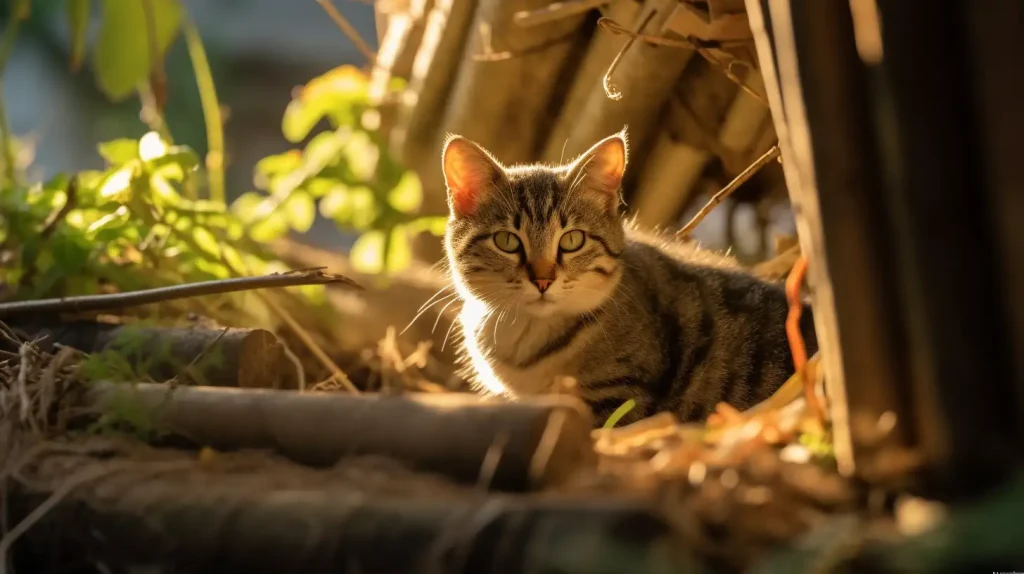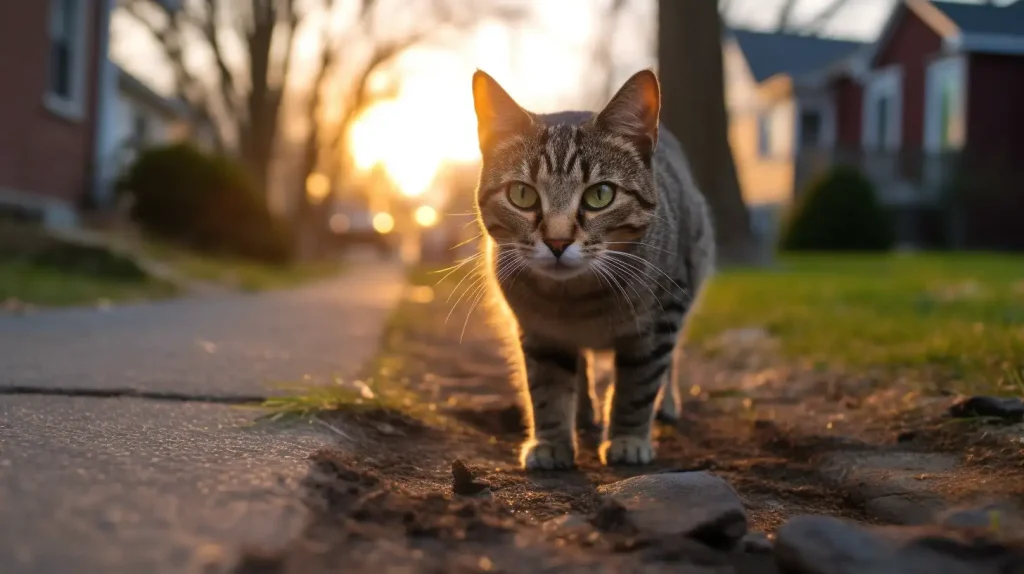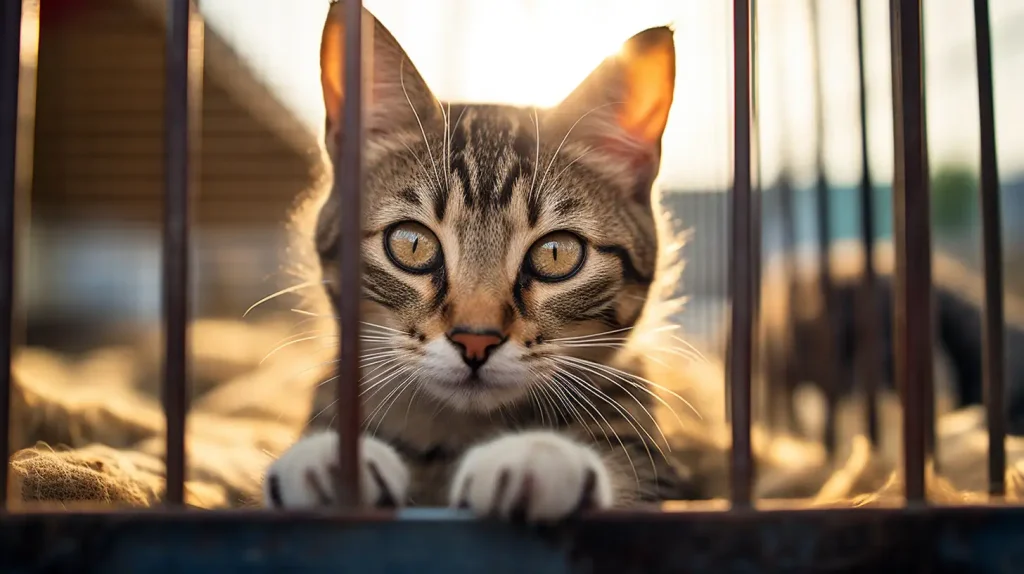Table of Contents
Adopting a stray cat can be a very rewarding experience. It is an experience that benefits both the cat and the adopter just as long as things are done in a certain way. But therein lies the rub. It is entirely possible to adopt a stray only to not handle the animal in an appropriate way, leading to an uncomfortable experience for both human and animal.
This guide is intended to act as a bit of helpful advice for adopting a stray cat. Anyone seeking to adopt a stray cat should take advantage of every available resource of information. That includes asking questions of veterinarians, shelter workers, animal charity organizations, and other experts.
Learn the Difference Between Stray and Feral
The first and most important piece of advice anyone could give is for you to learn the difference between a stray and feral cat. Not only is the difference big, but it will ultimately impact the adoption scenario.
A stray cat is one that is or was a pet. A stray cat is used to being around humans; it is probably not used to surviving outdoors and alone. A feral cat is just the opposite. A feral cat has never been a pet. It was born ‘in the wild’ and has always lived as such. That means it has had very little human contact.
Knowing the difference is important if you are planning to adopt a cat who seems to have adopted you by showing up on your porch looking for food. If there is any reason to suspect you are dealing with a feral cat, adoption is not a wise idea. Feral cats will definitely not make good house pets.
Understanding Cat Behavior and Body Language
Observing and understanding a cat’s behavior and body language can be a fascinating, yet essential component in building a strong bond with your newly adopted stray cat. Cats communicate their emotions, needs, and intentions through a rich vocabulary of body language and vocal cues.
Feline Body Postures
An upright tail, for instance, typically indicates a cat feeling relaxed and confident, often seen when they are happy to see you. However, a low-hanging or puffed-up tail can denote fear or aggression. A cat curling its tail around you is often a friendly gesture, much like a human handshake.
Understanding the subtle signals given by your cat’s ears is equally essential. Forward-facing ears suggest curiosity or pleasure, while flattened or turned-back ears may signal fear, aggression, or irritation. A cat’s eyes can also be telling – narrowed pupils often indicate aggression or fear, while dilated pupils can signify excitement or affection.
Vocal Communication
Aside from body language, cats also have a diverse range of vocal cues. A soft purr generally denotes contentment, while a hissing or growling cat is clearly agitated or fearful. Cats also communicate through a variety of meows, which can differ in tone, pitch, and volume. A high-pitched meow is generally associated with a friendly or plaintive tone, while a low-pitched meow can indicate dissatisfaction or impatience. Decoding these meows can be an art, but with time, you will get better at understanding what your cat is trying to communicate.
Learning to ‘speak cat’ can greatly assist you in understanding and meeting the needs of your adopted stray, ultimately leading to a more harmonious relationship. Keep in mind, however, that like people, cats are individuals. Not every cat will follow these general behavioral norms, so it’s crucial to observe and learn your unique feline’s language.

Consider Adopting from a Shelter
With the idea of feral cats out of the way, some experts recommend limiting adoption to cats already living in shelters. These are cats that have been brought to the shelter either by owners who could no longer care for them or people who found them roaming around in their neighborhoods.
One of the benefits of adopting from a shelter is that the shelter will have done a thorough physical examination of the cat before offering it for adoption. When you adopt from a shelter, you know you will be getting an animal that is in reasonably good health. The cat should be current with its shots as well.
Also note that shelters are unlikely to put a cat up for adoption if they believe the animal cannot be properly socialized as a pet. This means you can be reasonably sure that the animal you adopt is not going to exhibit violent tendencies or other antisocial behaviors.
Preparing Your Home for a Stray Cat
Before you welcome your new feline friend into your home, you’ll need to take some crucial steps to ensure a smooth transition for both you and the cat. Preparing your home effectively is a critical part of the adoption process and can help facilitate the cat’s adjustment to its new environment.
Clear the Space
Firstly, it’s essential to clear the space and ensure it’s safe for the cat. Stray cats, which may be unfamiliar with living in a home environment, could be more prone to accidents. So, make sure you secure loose wires and ensure small objects, toxic substances, and fragile items are out of reach. It’s also a good idea to secure window screens and doors to prevent the cat from escaping.
Create a Safe Zone
Next, create a safe zone for the cat. Stray cats may feel overwhelmed in a new environment, so having a dedicated quiet and comfortable space can help them adjust. This could be a spare room or a quiet corner where the cat can retreat and gradually get used to the sights, sounds, and smells of its new home.
Set Up Essential Supplies
Once you have chosen a safe zone, it’s time to set up essential supplies. These include food and water dishes, a litter box, and a comfortable bed. It might be helpful to place the litter box away from the food and water dishes as cats usually prefer these areas to be separate.
Cat-Proof Your Home
Lastly, cat-proof your home. Ensure there are no plants that can be toxic to cats, secure loose wires, and cover sharp edges or corners that could potentially harm the cat. If you have blinds or drapes with long cords, be sure to secure them as they can pose a strangulation hazard.
By carefully preparing your home for a stray cat, you’re setting the foundation for a successful adoption, helping the cat to settle in and feel comfortable in its new surroundings. After all, a bit of preparation goes a long way in making your new feline family member feel right at home.
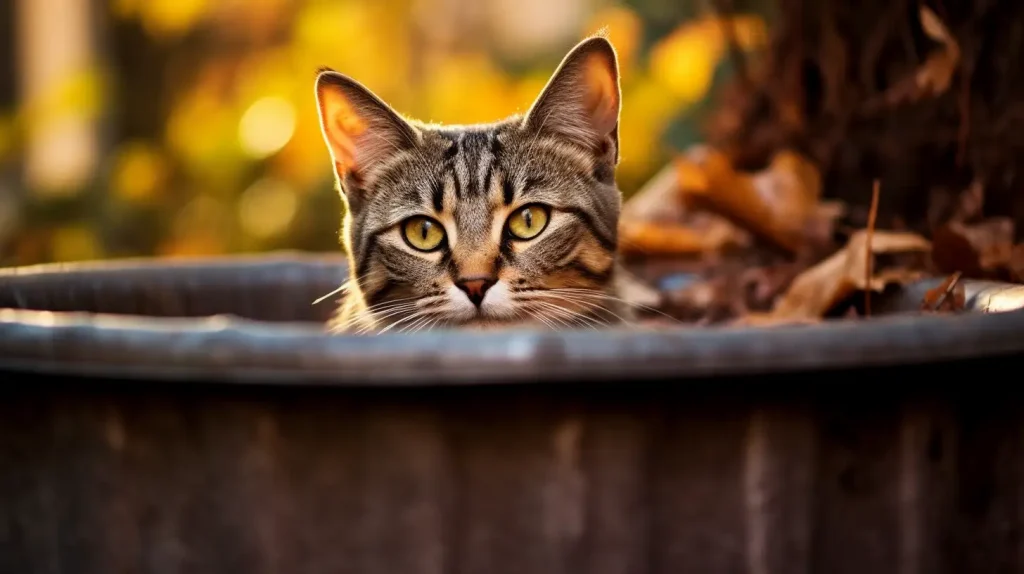
Make Medical Care a Priority: Including Regular Vaccinations and Preventive Treatments
Whether you adopt from a shelter or take in a stray cat that showed up at your door, make medical care a priority. Strays are often unhealthy because they have spent some time alone in an environment they are not familiar with. They may be malnourished; they may be suffering from injury or disease.
An immediate medical evaluation is appropriate for a stray cat you adopt from your neighborhood. That same medical care will be provided by default in a shelter environment. After adoption though, you should make medical care a routine practice until such time as your veterinarian is confident that the animal is in good health.
Routine Vaccinations
Crucial to this medical care regimen are regular vaccinations and preventive treatments. Your cat should be routinely vaccinated against common diseases such as feline leukemia virus (FeLV), feline immunodeficiency virus (FIV), rabies, and others based on your vet’s recommendations. Regular boosters will be needed to ensure continued protection.
In addition to vaccinations, preventive treatments for fleas, ticks, and worms are essential. These pests not only cause discomfort and irritation, but they can also carry diseases. Many products on the market can help prevent infestations, ranging from spot-on treatments to oral medications. Your vet can guide you in choosing the most appropriate product based on your cat’s age, weight, health status, and lifestyle.
Hand-in-hand with medical care is knowing the regulations in your local area. Some municipalities require immunizations for cats just as they do dogs. Other municipalities don’t care. Should you plan to allow your cat to spend some time outdoors, also note that there may be ordinances in place regarding spaying and neutering.
As long as we’re talking about spaying and neutering, don’t take any chances with your adopted cat. Unless you have adopted a female that you know for certain you want to breed, have her spayed. Remember that cats are prolific animals. One of the reasons there are so many strays and feral cats is that they reproduce so quickly. The priority should be to maintain your cat’s health and well-being, and that includes controlling the stray and feral cat population by responsible spaying and neutering.
Feeding Guide for Adopted Cats
Providing proper nutrition is a vital part of caring for your newly adopted cat. Depending on their previous living conditions, their nutritional needs might have been neglected, so it’s your role now to ensure they receive balanced meals that contribute to their overall health.
When you bring your cat home, it’s crucial to understand the nutritional needs that match their age, weight, and health condition. Generally, cats require a diet high in protein, moderate in fats, and low in carbohydrates. Cats are obligate carnivores, which means they thrive on meat-based diets.
To select an appropriate type of food, you have several options: dry kibble, canned wet food, or a combination of both. Dry food is often cost-effective and convenient for free-feeding since it doesn’t spoil quickly. On the other hand, wet food, which contains more moisture, is beneficial for cats’ hydration and is often more appetizing to them. It’s also easier for older cats or those with dental issues to consume. Depending on your cat’s preference and your veterinarian’s recommendation, you might find a balance between both.
Transitioning from an Old Diet
Transitioning your adopted cat from their old diet to a new one should be a gradual process. If possible, start by feeding them the same food they were receiving in their previous environment. Then, slowly introduce the new food by mixing it into their current food. Start with a small amount of the new food, gradually increasing its proportion over seven to ten days.
For instance, on the first couple of days, the mixture should be about 75% old food and 25% new food. After a few days, change the ratio to 50% old food and 50% new food. Then, transition to 75% new food and 25% old food. By the end of the transition period, your cat should be fully acclimated to the new diet.
By being attentive to your cat’s feeding habits and preferences, you can ensure they receive the nutrition they need while enjoying their meals. Remember, it’s always a good idea to consult with a vet before making any significant changes to your cat’s diet. Proper nutrition can greatly contribute to your cat’s health, longevity, and quality of life.
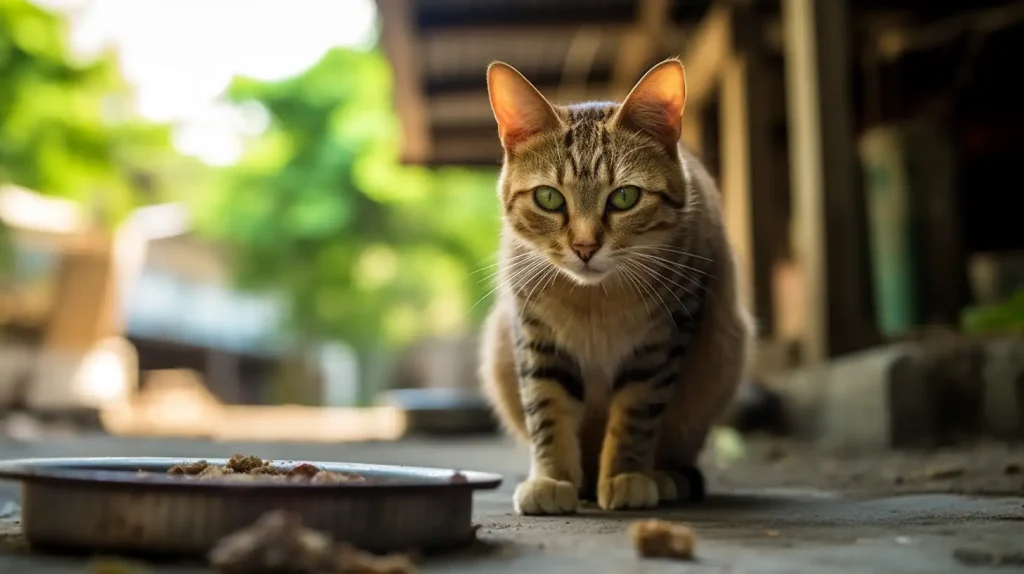
Be Patient with Socialization
Socializing a stray cat, particularly one with a troubled past, can indeed be a slow and careful process. Remember that some cats, especially those from shelters, may require additional time and patience to become comfortable with their new surroundings. Being creatures of habit and routine, cats thrive on familiarity and stability. They need time to adjust to their new environment and the new humans in their lives.
Here are some additional tips for dealing with cats displaying fear or aggression and for making introductions to other pets in the household:
Dealing with Fearful or Aggressive Behavior
Respect Their Space – Cats displaying fear or aggression need their personal space respected. This builds trust and helps them feel less threatened. Gradually encroach their space over time as they become more comfortable.
Use Gentle, Non-Threatening Body Language – Avoid staring directly into your cat’s eyes, as they can perceive this as a threat. Similarly, when you approach your cat, bend down to their level and extend a hand slowly for them to sniff. Always let the cat make the first move.
Consult a Veterinarian or Animal Behaviorist – If your cat continues to display aggressive behavior despite your best efforts, it may be a good idea to consult a professional. There could be underlying health issues, or the cat may be experiencing fear or anxiety that requires professional intervention.
Introducing the Cat to Other Pets
Introductions Must Be Gradual – First impressions matter to cats, so introductions to other pets must be handled with care. Initially, keep your new cat in a separate room with its food, water, and litter box. This allows both the resident pets and the new cat to get used to each other’s scent without any face-to-face confrontation.
Swap Scents – Swap bedding between the new cat and existing pets or rub a soft cloth on the new cat and place it near the existing pets, and vice versa. This can help familiarize them with each other’s scent.
Facilitate Controlled Face-to-Face Meeting – After a few days of scent swapping, if there are no signs of aggression like hissing or growling at the doors, you can try a face-to-face introduction. This should be done in a controlled environment, with each animal being handled by a separate person, or the new cat in a crate, to prevent any unexpected conflicts.
Monitor Interactions Closely – Even after successful introductions, continue monitoring their interactions for a while to ensure they are adjusting well to each other.
Remember, every cat is unique, and their pace of adjustment can vary widely. Patience, persistence, and understanding are the keys to a successful transition.
Creating a Bond: Spending Time with the Cat
Building a bond with your newly adopted cat is crucial in ensuring a smooth transition into its new environment. Quality time spent with your cat not only nurtures a relationship based on trust and mutual respect but also helps your pet feel safe and loved in its new home.
Understanding the Cat’s Body Language
One of the first steps in establishing a bond with your cat is understanding its body language. Cats have a diverse range of vocalizations and physical cues that indicate their mood and feelings. For instance, a slow blink from a cat is considered a sign of trust and affection, and returning the gesture can reinforce your bond. On the other hand, an agitated tail or flattened ears may suggest that your cat is upset or anxious, and it’s best to give them some space.
Interactive Playtime
Engaging in interactive play sessions is a fantastic way to create a strong bond with your cat. Not only does it provide essential mental and physical stimulation, but it also gives your cat positive associations with you. Use toys that stimulate your cat’s hunting instincts, such as toy mice or feathered wands. Remember to allow your cat to ‘catch’ the toy occasionally, as this can increase their sense of satisfaction and happiness.
Gentle Grooming
Most cats enjoy being gently groomed. It can be a bonding activity that mimics the social behavior of cats in the wild. Brush your cat regularly, especially if it has a long coat. Besides preventing matting and hairballs, this action can provide a soothing massage and demonstrate your care.
Respect Their Space and Routines
Cats appreciate routine and can be very particular about their personal space. Be consistent in your daily interactions and respect their need for solitude. Remember that bonding doesn’t mean constant interaction; sometimes, the best way to show love is by allowing them to have their alone time.
Building a bond with your cat takes patience and understanding. But the trust and friendship you’ll form with your feline companion will make the effort worthwhile. Remember, each cat is unique, and it’s essential to move at a pace your cat is comfortable with.
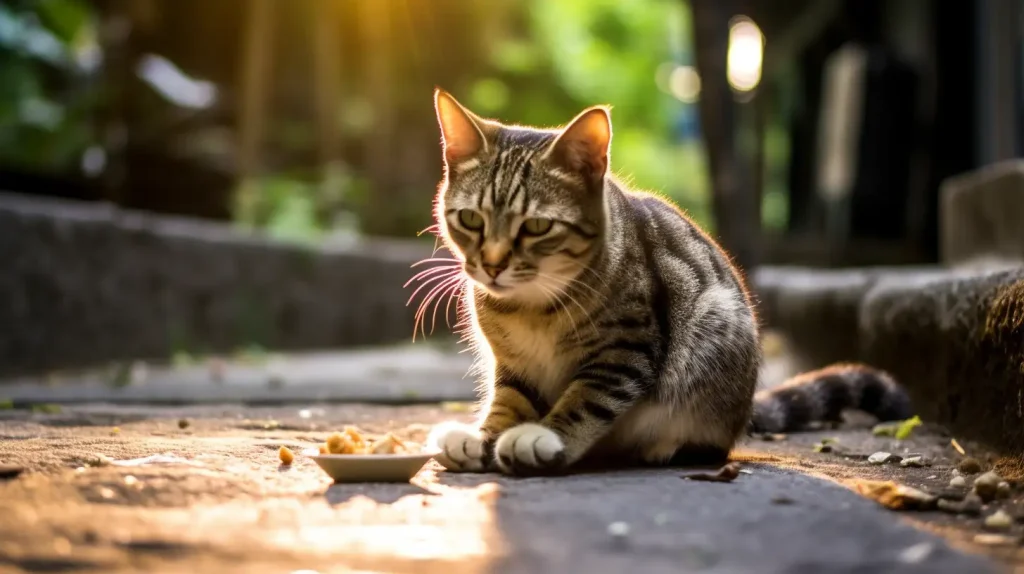
Establish a Feeding Schedule
Once your newly adopted cat gets over the initial fear and apprehension that has her hiding throughout most of the day, it’s time to pull back on the food. Stray cats that have been left alone long enough begin to act as though they are always starving. They eat anything and everything they can get their paws on.
This habit has to be broken for the cat’s health. The best way to do this is to establish a feeding schedule. Set food and water out at the same time every day. Give the cat a certain amount of time to eat, then take the food away. Your cat will eventually adjust to the schedule. You will benefit by not having to constantly worry about a full food dish; the cat will no longer be tempted to overeat.
While we are on this topic, you may find that your cat is a finicky eater. Don’t make things worse by constantly changing the food you provide. Once you find something that the cat likes, stick with it. There is no need to continually buy different food varieties to keep things new and exciting. Animals do not view food the same way humans do. They don’t care if it is ‘gourmet’, ‘artisan’, or anything else. And they certainly don’t need variety in the same sense that we humans do.
Training the Cat: Litter Training, Scratching, Etc.
Litter Training
Even if your newly adopted cat is an adult, they may require training in certain areas. For instance, litter training can often be a necessity. Cats, by nature, are clean creatures and prefer to eliminate in a clean, designated area. An adult cat, especially a stray, might not be used to using a litter box. However, their natural instincts make them apt learners. Start by selecting a quiet, accessible corner for the litter box, away from their food and water. Ensure that the box is large enough for the cat to turn around comfortably. It’s a good idea to show them where the box is located, gently placing them inside to make them familiar. Cats usually catch on quite quickly, but if your cat seems to be struggling, a bit of patience and consistency will go a long way.
Scratch Training
Next, let’s tackle the common issue of scratching. Scratching is an essential part of a cat’s behavior. It helps them stretch their bodies, mark their territory, and keep their claws healthy. Instead of stopping this natural behavior, provide them with an appropriate outlet. Introduce scratch posts or mats to your home and encourage their use. Place these items near the furniture they seem fond of scratching or in their favorite areas. Infusing the posts with catnip or hanging toys can make them more appealing. If your cat continues to scratch furniture, don’t scold them harshly. Instead, gently redirect them to the scratching post. Over time, they’ll learn the appropriate places to scratch.
Remember, training an adult cat might take a bit more time than a kitten, as they may be set in their ways. Patience, gentleness, and understanding will be your best tools during this process. After all, you’re not just training your cat – you’re building trust and establishing a rewarding companionship with them.
Understanding and Accommodating the Cat’s Sleeping Preferences
While humans may find the presence of their feline friends comforting at bedtime, it’s important to remember that each cat is an individual with unique preferences, particularly when it comes to sleeping arrangements. Newly adopted stray cats, in particular, might not initially be comfortable enough to share your bed. This is often due to unfamiliarity with their new environment and the people in it. It’s not a rejection of your affection, but rather a display of their natural instinct for safety and security.
Contrary to your preference for your cat to jump up on the bed and snuggle in for the night, it might opt for a secluded corner where it feels protected by the surrounding furniture. This is a common behavior for cats, particularly those adjusting to new surroundings, as enclosed spaces make them feel safe and secure.
Interestingly, some cats might be more inclined to join you in bed only after you’ve fully settled in for the night. They might also choose to leave as soon as you start to stir in the morning. This behavior implies that while your cat is comfortable enough to sleep in your presence, it may still harbor enough apprehension to prefer distance when you’re awake and moving about. Be patient and understanding; given time, most cats will become more confident and comfortable in their new environment.
To make this adjustment period easier and more comfortable for your adopted stray cat, consider providing a variety of appropriate sleeping arrangements throughout your home. Remember, a good cat bed doesn’t have to be expensive or fancy; what matters most is comfort and a sense of security.
- Cozy Cat Beds: Plush, soft beds with raised edges provide a warm and secure place for your cat to rest. Ensure the bed is located in a quiet, low-traffic area of your home where your cat won’t be frequently disturbed.
- Cat Trees or Perches: Many cats love to sleep in high places where they can survey their territory. Cat trees with built-in sleeping areas or platforms are an excellent choice, offering both a play area and a cozy nap spot.
- Heated Beds: For colder climates or simply for cats who love a warm spot, heated beds can be a delightful sleeping arrangement. These are available in pet stores and can provide a comforting heat source that many cats enjoy.
- Cardboard Boxes: Never underestimate the appeal of a simple cardboard box. Many cats love the security these provide. Adding a soft blanket or towel can make this a perfect and cost-effective bed.
- : These offer a sense of safety and privacy, which can be particularly comforting for shy or nervous cats. They come in various sizes and styles to suit your home decor.
- Window Perches: Cats love to bask in the sun and watch the world go by. A window perch can offer a sunny spot for a cat nap and hours of entertainment.
While accommodating your cat’s sleeping preferences, remember that it’s perfectly okay if your cat chooses not to sleep on your bed. What’s essential is ensuring your cat feels secure, comfortable, and loved in its new home. With time and patience, your furry friend will settle into their preferred sleeping routine, enhancing their overall well-being and the bond between you two.
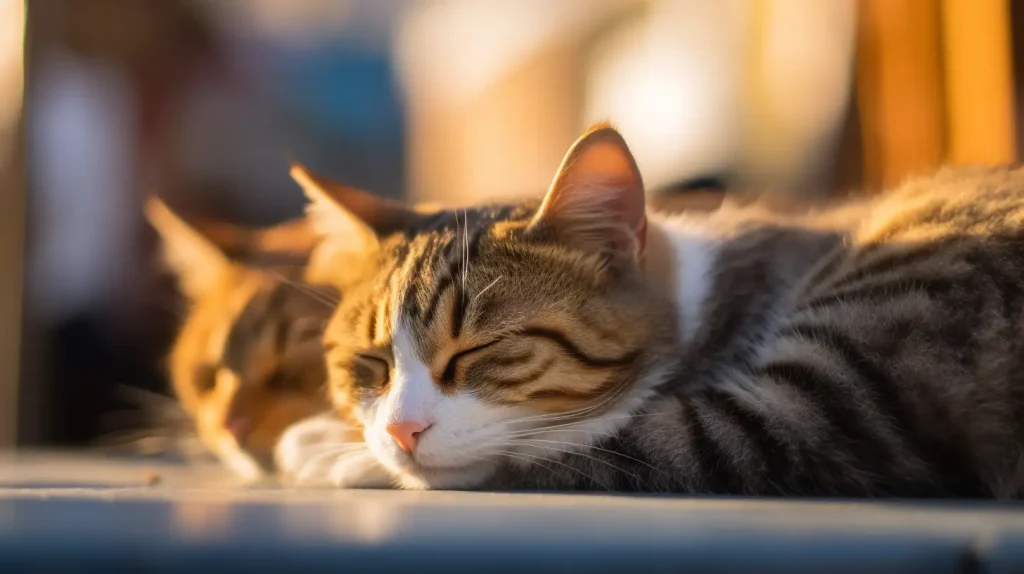
Working with the Cat to Stay Mentally and Physically Sharp
Another piece of advice in the process of adopting a stray cat is to consistently engage your cat in activities that promote its natural instincts and abilities. Cats are naturally inclined to be hunters. Their day-to-day behavior is usually dominated by periods of long rest, interjected with short bursts of intense activity meant to simulate their inherent urge to hunt.
During their active periods, cats often explore their surroundings, a behavior that stems from their hunting instincts. They’re not just passing time – they’re essentially on a hunt. As a cat parent, you can use this to your advantage to ensure your cat stays mentally and physically sharp. Engaging them in stimulating play is the perfect way to do this.
Interactive Toys
A wide range of interactive toys is available in the market, all designed to stimulate different aspects of a cat’s hunting instinct. Some of the popular choices include:
- Laser Pointers: Just as mentioned before, cats absolutely love to chase laser pointers. It satisfies their natural inclination to stalk and chase. However, be sure to never shine the laser directly in a cat’s eyes, as it can cause damage.
- Puzzle Toys: These toys often hide treats inside them and require the cat to solve the puzzle to get the treat. These can help stimulate a cat’s problem-solving skills and are an excellent way to keep them busy.
- Wand Toys: These toys typically consist of a wand with a string attached to one end and a small toy or feather on the other end. When you move the wand, the toy or feather mimics the movement of a bird or small creature, stimulating the cat’s instinct to stalk and pounce.
- Motorized Toys: These are electronic toys that move or make noise, stimulating a cat’s instincts to chase and capture their ‘prey’. These are especially useful when you are not around to engage with your cat directly.
Importance of Environmental Enrichment
Environmental enrichment refers to the process of making an animal’s living space more engaging and fulfilling. For cats, this can include things like scratching posts, climbing trees, cozy hiding spots, and access to window views for observing the outside world. Having these elements in your home encourages physical activity and reduces stress and boredom, ultimately leading to improved health and well-being.
Impact of Mental Stimulation on a Cat’s Well-being
Engaging your cat in mental stimulation and providing an enriched environment has a profound impact on its well-being. Regular play and mental challenges help prevent obesity, reduce destructive behaviors caused by boredom, and decrease the risk of depression and other behavioral issues. Moreover, play is an excellent way for you and your cat to bond, helping to foster a stronger and more rewarding relationship.
Remember, mental stimulation is as important for your cat’s overall health as their physical well-being. In addition to regular veterinary care and proper nutrition, ensure that you are dedicating time each day for interactive play with your cat. It keeps them happy, healthy, and sharp in their new loving home.
Long-Term Commitment: The Cat’s Life Expectancy and What It Means for You
When considering the adoption of a stray cat, understanding the time commitment involved is a crucial part of the decision-making process. In general, cats have a lifespan ranging from 10 to 15 years, though it’s not uncommon for some to live into their late teens or early twenties, especially with advancements in veterinary care and nutrition.
As potential cat adopters, it’s essential to be prepared for this considerable commitment. Similar to us, cats grow and change with age, each stage bringing its unique joys and challenges.
Young and Middle-Aged Cats
A young cat might need plenty of play and engagement, ensuring they stay mentally and physically stimulated. Middle-aged cats, while generally more settled, may still require your attention for interactive play and regular health checks. This stage of their life is about maintenance and sustaining their well-being.
Senior Cats and the Twilight Years
As cats approach their senior years, they may face more health issues and will require frequent veterinary check-ups. They might need dietary changes, or their mobility might lessen. It’s essential to provide them with a comfortable and accessible environment, such as litter boxes and beds on each floor if you live in a multi-level home.
At this stage, cats typically slow down and may become more dependent on you for their care. It’s an emotional journey that requires patience and empathy, but the bond you form through these years can be deeply rewarding.
It’s also important to prepare yourself emotionally for the inevitability of your pet’s aging. There will come a time when you have to say goodbye. Coping with pet loss can be an emotionally challenging process. It’s okay to grieve and seek support when needed.
Adopting a cat is a journey of more than a decade filled with companionship, laughter, and shared experiences. The cat will not just be a pet but a part of your family. Understanding this long-term commitment can help ensure that the cat you bring home will be cared for, loved, and cherished for its entire lifespan.
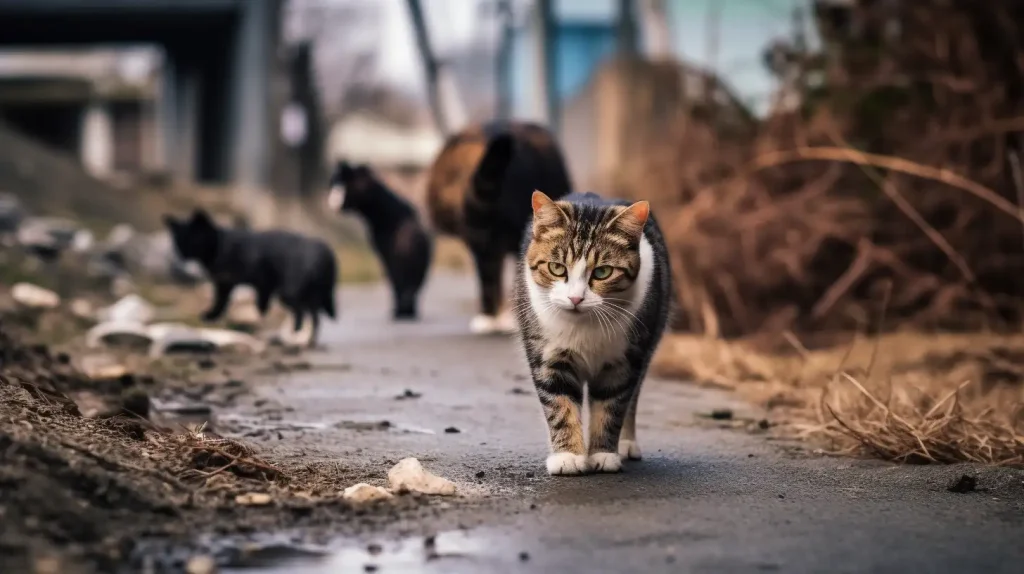
Coping with Potential Loss: Illness and Ageing in Cats
For many, the bond with their feline companion runs deep, and the thought of potential loss due to illness or aging can be difficult to consider. Nonetheless, being prepared and informed can help ease the process.
As your cat enters its senior years (usually around 10 years old), you may begin to notice some changes in its behavior, energy levels, and physical condition. Regular check-ups become more critical at this stage. It’s advisable to schedule bi-annual veterinary visits for older cats, even if they seem perfectly healthy. These visits often include blood work, urine analysis, and dental checkups to catch any potential health issues early.
The senior years are also a time when chronic illnesses are more likely to appear. Conditions like kidney disease, diabetes, arthritis, and hyperthyroidism are quite common among older cats. If your cat is diagnosed with a chronic condition, remember it’s not the end of the world. With appropriate veterinary care, medication, and diet adjustments, many of these conditions can be managed, allowing your cat to live a comfortable and happy life.
Understanding and Responding to the Signs of Ageing
Cats are masters at hiding their discomfort, a skill inherited from their wild ancestors who had to mask their weakness from predators. So, it’s up to you to spot the subtle signs of aging and illness in your cat. Changes in eating habits, weight loss or gain, a decrease in grooming, increased lethargy, or changes in their bathroom habits can all be signs that your cat may be dealing with a health issue.
Providing a comfortable and stress-free environment for your aging cat is essential. Small modifications like placing litter boxes and food dishes on every floor (for cats with mobility issues) or warming their food to increase its smell (for cats with decreased appetite) can make a significant difference in their quality of life.
Preparing for the Inevitable
Even with the best care, there comes a time when we must say goodbye to our feline companions. This stage can be the most challenging part of owning a pet. If your cat has been diagnosed with a terminal condition or its quality of life has significantly diminished, it’s important to discuss end-of-life care and euthanasia with your veterinarian. The goal is to ensure your cat’s remaining days are comfortable and dignified. Having a support system in place, such as understanding friends, family, or pet loss support groups, can be incredibly helpful during this time.
Remember, it’s perfectly okay and completely normal to grieve. Losing a pet is losing a member of your family. Give yourself the time and space to heal and remember the joy your cat brought to your life. While the pain of loss can be immense, the companionship, affection, and the bond you shared with your cat make it all worth it.
Adopting a Stray Cat – Conclusion
Adopting a stray cat requires a certain level of commitment. If you are willing to put forth the effort, adoption can be a very rewarding experience for you and your cat. Hopefully, the advice you gleaned from this guide will be useful to your endeavors as a pet owner.
If you have any questions about pet adoption, your local shelter can probably answer them. Any medical questions should be referred to a qualified veterinarian. Above all, know that you will get out of your cat adoption what you put into it. The more time and effort you give to your cat, the better your relationship will be.
Key Takeaways
- Understanding a cat’s nutritional needs based on age, weight, and health is essential for their overall well-being.
- Cats require a diet high in protein, moderate in fats, and low in carbohydrates because they are obligate carnivores.
- Selecting appropriate types of food, including dry kibble, canned wet food, or a combination of both, is necessary for maintaining a cat’s health.
- Respectful handling of a cat displaying fear or aggression is important to build trust and reduce potential threats to their safety.
- Establishing a feeding schedule can help break the habit of overeating and ensure a cat’s health.
- Providing appropriate scratching posts and litter boxes can help maintain a cat’s hygiene and reduce potential damage to the household items.
- Adapting to a cat’s health conditions or mobility issues by making small modifications, such as placing food dishes and litter boxes on every floor or warming their food, can improve their quality of life.
- Preparing for end-of-life care and euthanasia is essential for ensuring a cat’s comfort and dignity.
COPYRIGHT NOTICE
Please be advised that all images, designs, and creative content on this page are the exclusive property of Stray-Cat-Advice.com and are protected under international copyright laws. The images may not be reproduced, copied, transmitted or manipulated without the written permission of stray-cat-advice.com.
Unauthorized use, distribution, display, or creation of derivative works of any images contained on this site, is strictly prohibited and can lead to legal penalties. We actively monitor for, and enforce, our copyright interests.
If you wish to use any of our images, kindly contact us to seek permission. Respect of copyright is not merely a legal requirement but also an acknowledgement and support of the hard work and creativity that goes into producing them.
Thank you for your understanding and cooperation.
© 2023, stray-cat-advice.com. All Rights Reserved.

